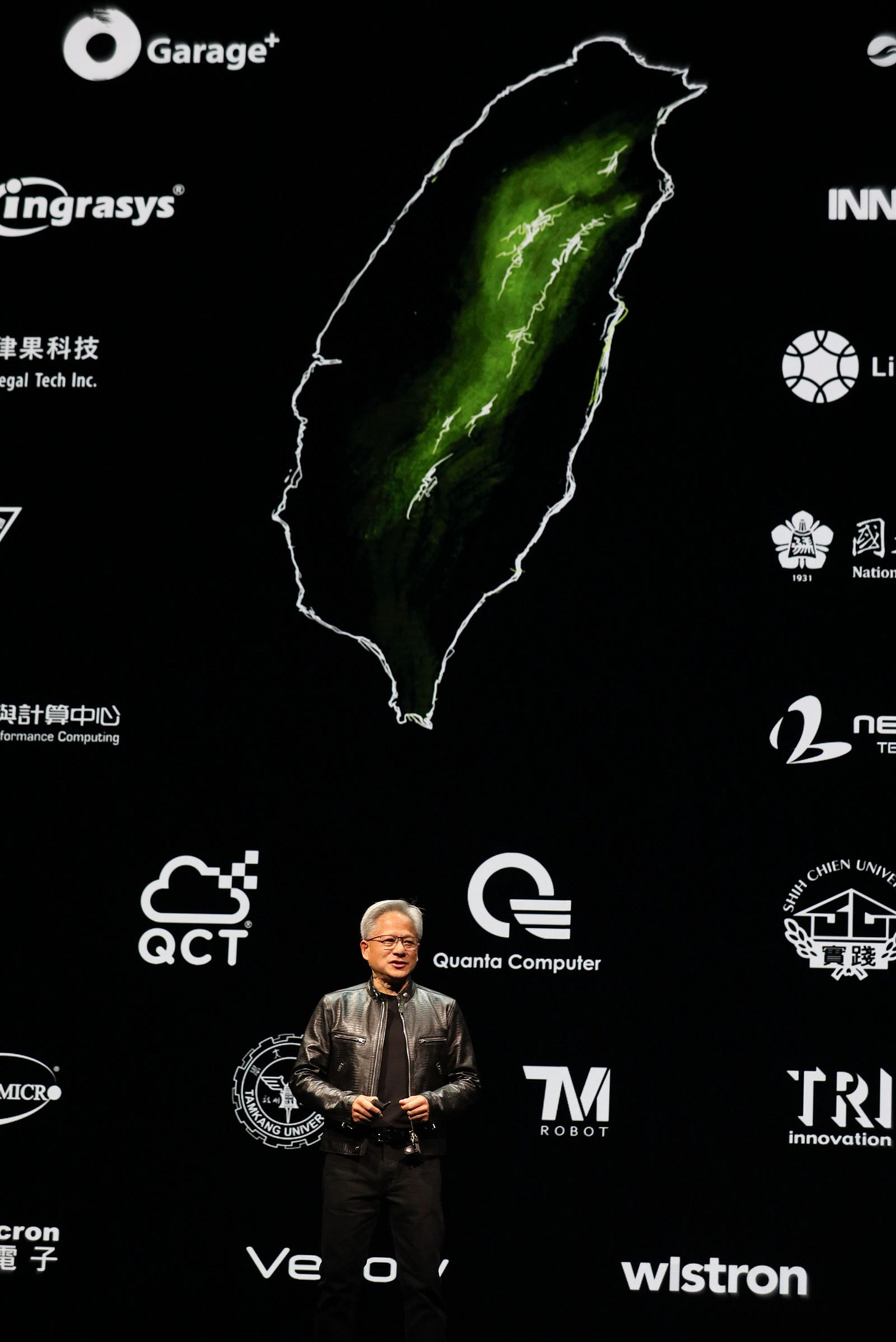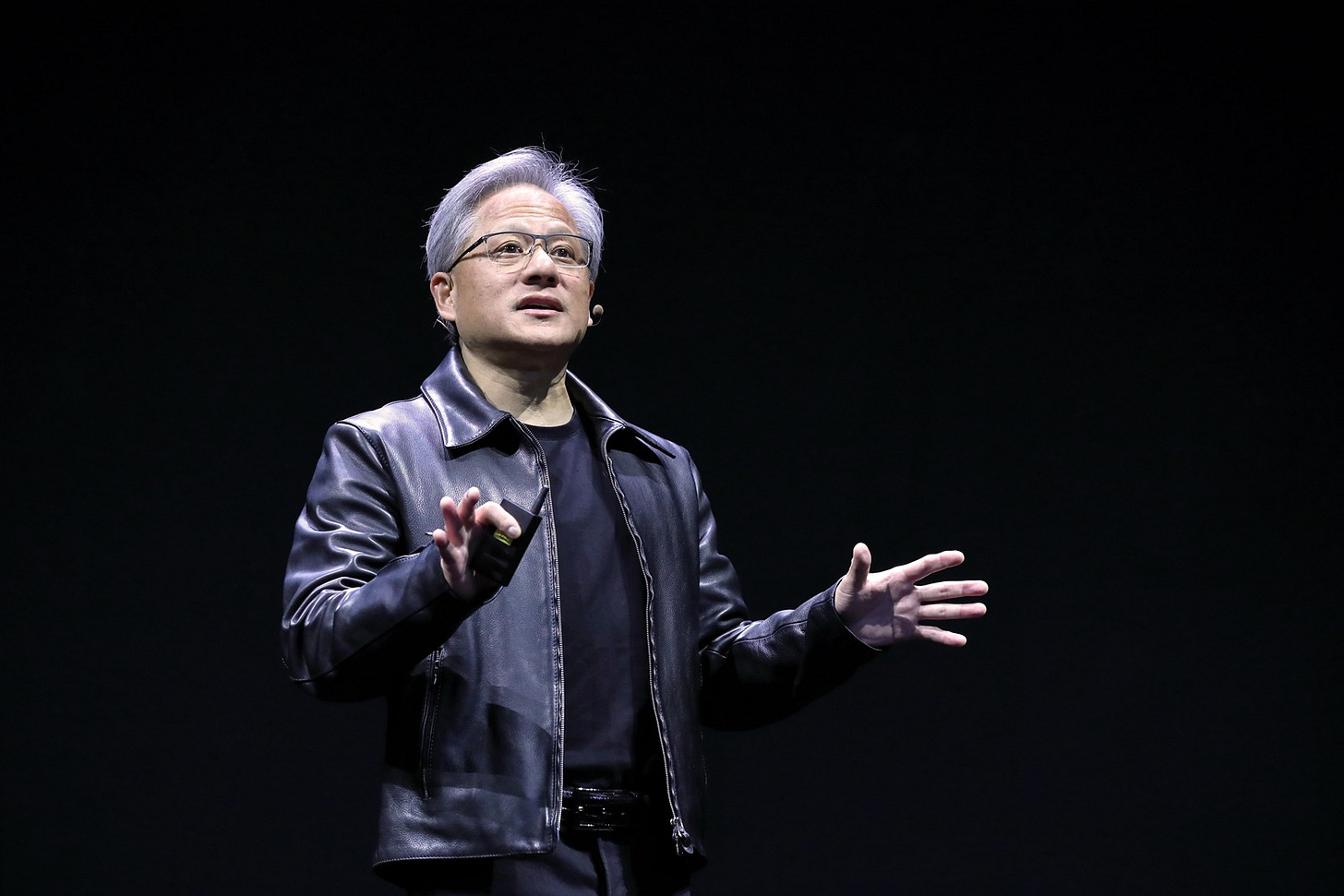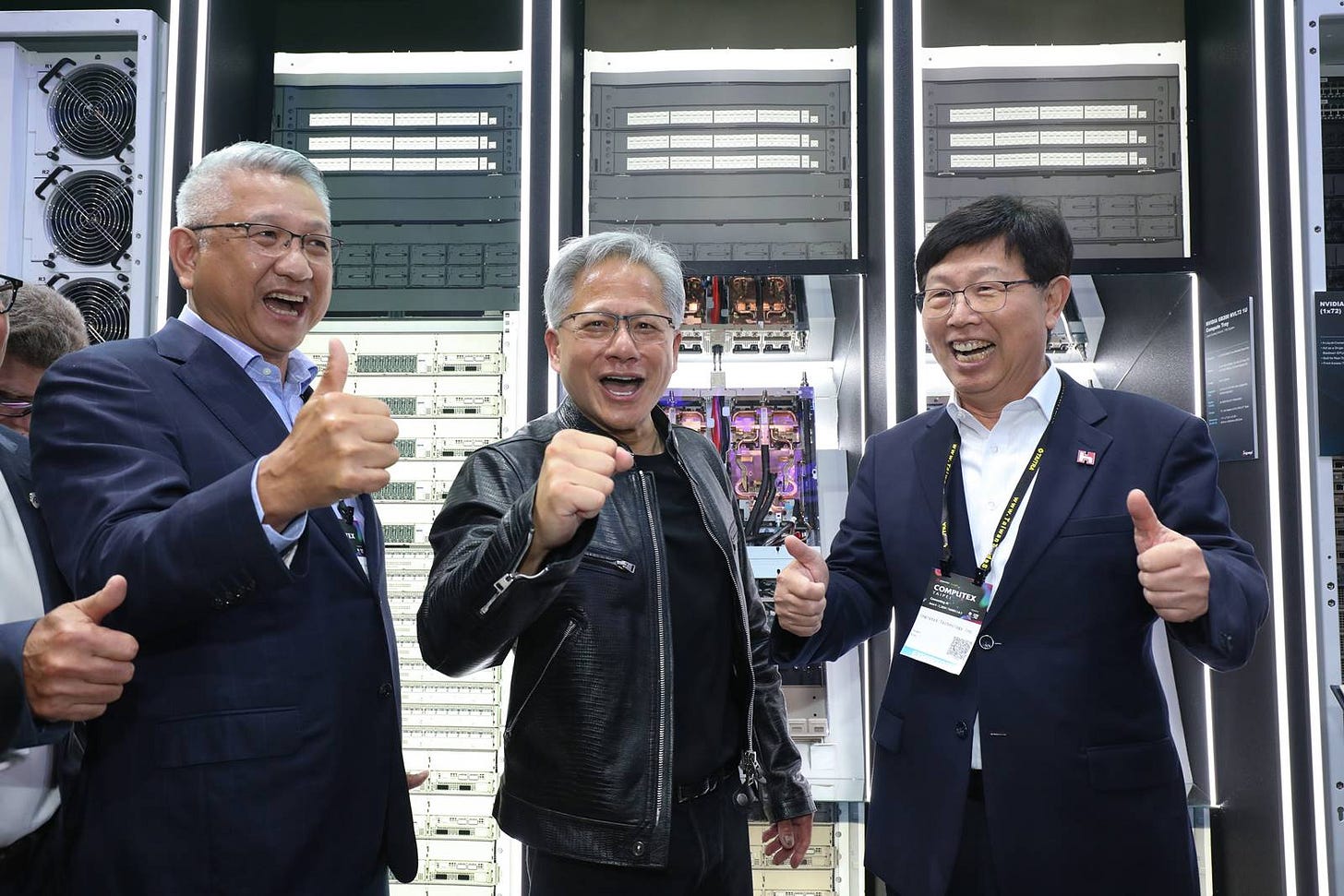Riding with Nvidia, Rising to Glory! But Why Do Taiwanese Firms Still Prefer Apple?
Liang-rong Chen
Hello everyone,
Two nights ago, I ran into an old friend at an event hosted by Taiwan’s local think tank, Research Institute for Democracy, Society and Emerging Technology (DSET): Chris Miller, author of Chip War.
He had told me more than a month ago that he’d be coming to Taiwan at the end of March, but only for two days.
I was curious—why such a short visit?
When we met, he couldn’t help but reveal that he had an appointment with Morris Chang the next day, and that’s why he flew in today.
Interesting. This is now the second time I’ve become a warm-up act during the brief downtime of a global heavyweight flying into Taiwan to see Morris Chang.
The previous time was over a year ago, when I interviewed OpenAI co-founder Sam Altman for half an hour during a short break in his Taiwan trip. Later, I found out he was heading to dinner with Morris Chang right after our interview.
The Oracle of Taipei
Warren Buffett, the reclusive chairman of Berkshire Hathaway who lives in a small agricultural town, is known as “The Oracle of Omaha.”
Today, Morris Chang holds a similar international stature—he’s essentially “The Oracle of Taipei.” I believe there are more world-class leaders quietly flying into Taipei on pilgrimages than we know.
Anyway, at the warm-up event I mentioned earlier, I asked Miller a question.
When Donald Trump had just assumed office this January, Miller appeared on my podcast and remarked that although Trump had accused Taiwan of "stealing America’s chip industry," it was nothing more than campaign rhetoric. There was no need to worry that he would actually take action against Taiwan’s semiconductor sector.
Readers will know by now that this prediction didn’t quite hold up. Trump was dead serious—and kept bringing it up, all the way to TSMC recently announcing an additional $100 billion investment in the U.S.
I asked Miller why he misread Trump. (To be fair, most people did.)
He didn’t answer directly. He only said that because Trump no longer faces re-election pressure, he’s now determined to realize his vision of reshaping the U.S. trade structure. The scale and urgency of his actions may surprise people.
Back to this week’s newsletter—this is the third installment of our promised series on the Nvidia supply chain.

Last week’s Nvidia GTC was a vibrant display of new technologies. But when I spoke to several Nvidia supply chain managers and experts, the excitement wasn’t quite at the same level as last year.
Some were even worried—wondering if it’s still better to be part of Apple’s supply chain.
Why is that? Nvidia is poised to surpass Apple this year as TSMC’s largest customer. Taiwan is on its way from being “Apple Island” to becoming “Nvidia Island.” So why the hesitation?
Read on to find out.
Due to the secretive nature of Taiwan’s electronics manufacturing industry, interactions between clients and contract manufacturers rarely make it into the public eye.
TSMC’s former chairman, Morris Chang, however, is an exception. In the second volume of his autobiography, he recounts in detail his first meeting with Apple, which would later become TSMC’s largest customer.
What shocked me most was how Apple COO Jeff Williams, when asking TSMC to manufacture chips for iPhones, spoke with the tone of bestowing a favor: “We’ll let you enjoy a 40% gross margin.” That year, TSMC’s average gross margin was 48%.
This is quintessential Apple—not offering a price, but calculating your profit margin for you. It shows just how well they understand their suppliers’ cost structures.
Many Apple suppliers I’ve interviewed have said that being in Apple’s supply chain is a double-edged sword. You get cutting-edge technology, massive shipment volumes, and soaring stock prices—but Apple’s engineers are so technically savvy that suppliers can’t hide their profits. Apple will calculate a price that keeps you “never full, never starving.” It’s frustrating, but inescapable.
Another big customer story involves Nvidia. When Chang returned as CEO in 2009, his first priority was flying to Jensen Huang’s home in Silicon Valley to discuss who should bear responsibility for low 40nm yields, which had caused product losses for Nvidia. In the end, TSMC paid over $100 million in compensation.

Later, I heard that some inside TSMC had argued against the payout. TSMC had offered two sets of design guidelines for the 40nm process. Most customers chose the safer Design for Manufacturability (DFM) rules. But Nvidia, known for its aggressive approach, went with the riskier Minimum Design Rules—so shouldn't they accept the risk?
Some even questioned whether Chang had used company funds to bail out Jensen Huang, a close friend, whose company was struggling at the time.
In hindsight, however, Chang’s foresight was remarkable. That timely support has now yielded rich returns.
Bernstein estimates that TSMC’s AI data center revenue will surge from 6% of total revenue in 2023 to 14% in 2024, surpassing 20% in 2025—most of it from Nvidia.
A foreign analyst told me that with Nvidia’s GPUs exclusively manufactured by TSMC, the company is likely to overtake Apple this year as TSMC’s biggest client. “Their contributions will be neck and neck.”
This is a major milestone. Taiwan’s rapidly growing Nvidia supply chain is poised to overtake the Apple supply chain in both scale and influence, becoming the new mainstream in the electronics industry.
However, Jensen Huang’s appetite for risk and his tightrope-walking approach to new technologies mean that the entire industry must ride the same roller coaster.
For example, Nvidia’s new AI GPU series “Blackwell” involves extremely complex technology. Initial shipments fell short of expectations, making Nvidia’s supply chain anxious for months.
Huang had to do some damage control at mid-March’s GTC conference. In a rare move, he disclosed actual sales numbers: last year, Microsoft, Amazon, and other major cloud providers bought a total of 1.3 million Hopper GPUs (the previous generation). In just the first three months of 2025, they’ve already ordered 1.8 million Blackwell GPUs.
Morgan Stanley’s report the next day noted that since the new product is 1.6 times more expensive than the previous one, this translates into a 117% revenue increase. “Our original forecast of 55% growth in data center revenue this year now looks too conservative.”
Nvidia or Apple—Which Is the Better Ride?
With this kind of explosive growth momentum, Taiwanese companies riding the Nvidia wave are on a fast track to fortune. Compared to the iPhone boom a decade ago, Nvidia seems even more willing to engage deeply with Taiwanese suppliers.

It’s widely known that Apple only partners with top-tier suppliers. Despite years of buzz around Apple-related stocks in Taiwan, apart from rare exceptions like TSMC and Largan Precision, most Taiwanese firms are confined to lower-tech areas like assembly and casings.
Key chips for communications, sensing, and power management are still dominated by American, European, and Japanese giants. Even iPhone displays are monopolized by South Korean firms—AUO and Innolux have never made the cut.
Nvidia is different. At this GTC, the two most anticipated products for Taiwanese firms were network switches featuring silicon photonics—a cutting-edge technology. Despite the difficulty, a few Taiwanese suppliers made the early wave.
For instance, LandMark Optoelectronics (LMOC)’s micro-laser emitters were shipped to a major international client for the first time.
The core chips in Nvidia’s switches use TSMC’s COUPE silicon photonics platform, and the substrates are exclusively supplied by Unimicron. This marks the first time Unimicron has beaten out Japan’s Ibiden to supply a brand-new Nvidia product.
In fact, across Nvidia’s supply chain—especially in CoWoS packaging—a quiet revolution is underway. Japanese suppliers are being replaced by Taiwanese ones.
As mentioned in our early-March newsletter, the low-CTE fiberglass fabric used to reinforce Nvidia GPU substrates was once solely supplied by Japan’s Nitto Boseki. Starting in Q2, Taiwan Glass will break into this niche.
Why Does Nvidia Favor Taiwanese Firms?
Many instinctively assume it’s because Jensen Huang, born in Tainan, “loves Taiwan.”
“Not at all,” said a senior executive who supplies both Nvidia and Apple, laughing. He believes it’s mainly because Japanese suppliers can’t keep up with Nvidia’s pace.
“It really is light-speed,” he sighed.
First, the development-to-production cycle is lightning fast. Products launching next year have to be sampled this January or February. “If you don’t send samples, you’re out.”
Apple has also had similar situations in the past.
For example, Cyntec, a low-profile but billion-dollar component maker under Delta Electronics, is one of the few Taiwanese companies to have beaten Japanese rivals and become a major Apple supplier.
An industry insider told me Cyntec’s tech is on par with Japan’s Murata and TDK. But every iPhone generation requires custom inductors, and suppliers must ramp up from sample to tens of thousands per month within 3–6 months. “That kind of speed—Japanese firms just can’t match it. That’s how Cyntec got in.”
But compared to Apple, Nvidia moves even faster. “It’s not just the iteration, but also the adoption of new technologies,” said the senior exec mentioned earlier.
He believes only Taiwanese and Chinese firms can keep up with Nvidia’s pace. But due to the sensitive nature of AI tech, U.S. companies demand a supply chain decoupled from China—“so Chinese suppliers are completely excluded.”
Moreover, unlike Apple’s Taiwanese suppliers, who mostly use “Taiwanese tech, Chinese manufacturing,” the AI supply chain is largely staying in Taiwan due to decoupling.
Take, for example, Nvidia’s latest tech marvel: the GB200 NVL72 cabinet that crams 72 GPUs together, connects them via ultra-fast NVLink, and introduces water cooling for the first time. Nicknamed “the billion-dollar rack” (it costs nearly NT$100 million), its cooling systems and mechanical parts are all made in western Taiwan, where factories are expanding.
However, according to NTU computer science professor and former Foxconn advisor Shih-Hao Hung(洪士灝), who posted on Facebook recently, the cabinet’s production difficulties have delayed its originally scheduled rollout from late last year.
Is Riding with Nvidia a Guaranteed Path to Prosperity?
Even though Jensen Huang spent over two hours showcasing future products at this year’s GTC, some suppliers remained skeptical: “Who knows how long it’ll take for these to actually ship?”
One Nvidia supplier’s GM attended the event with cautious optimism.
He said that while Nvidia products are still in short supply this year and the supply chain is expanding rapidly, current demand is largely infrastructure-driven—it’s hard to sustain that forever.
“Everyone’s asking: When will Nvidia demand start dropping? Will it collapse like an avalanche? Maybe in the second half of 2026.”
In contrast, his other major client, Apple, makes consumer staples like iPhones and laptops. “No matter how bad the economy gets, there's still a base level of demand.”
These may be the growing pains Taiwan must endure as it transitions from “Apple Island” to “Nvidia Island.”
10-Second Tech Recap
Taiwan is undergoing a shift—from an “Apple Island” to a “Nvidia Island.”
Apple keeps its suppliers “never full, never starving,” yet some Taiwanese firms still feel it’s better to be in Apple’s supply chain.
Nvidia values Taiwanese suppliers even more than Apple does. With its breakneck pace, suppliers need top-tier technical capabilities and lightning-fast responsiveness just to keep up.
Read more here:
Why U.S. AI Chip Sanctions Aren’t Working? The Untold Secret from Nvidia’s GTC 25!
Exclusive|How Taiwan Glass Became Nvidia’s Unlikely Savior for GB200



